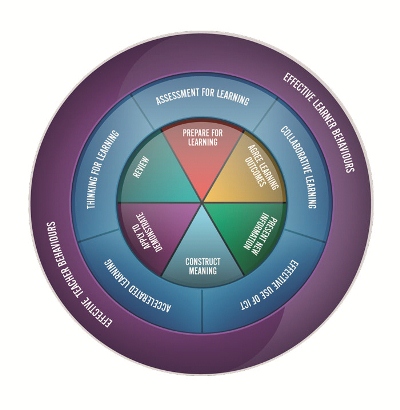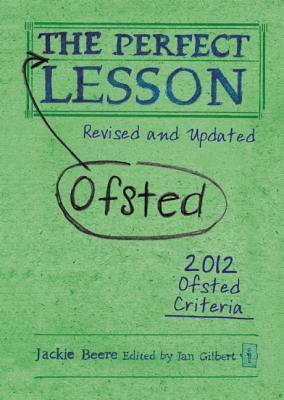The perfect (Ofsted) lesson
I used to be a bit of an expert at planning lessons. I’d spend a lot of time doing it. In my early years of teaching it was the (then still fairly cutting edge) 3 part lesson. Engaging starter to hook them in, a meaty main section (where I’d find devious ways for pupils to discover things for themselves) and a snappy plenary to check understanding. This later evolved into the 5 part Accelerated Learning cycle, and then (in a different school) the similar TEEP cycle. There was a real craftsmanship to planning lessons like this, but it was time consuming and (despite best intentions at the start of the academic year) it was totally unsustainable. In reality I’d only plan in that level of detail when I was being observed (which was fairly often) or when I was putting together lesson plans and resources for other Science teachers to use.

There were many problems with this approach. What happened if the main part took longer than anticipated? Do you plough on and stick with the timings in your lesson plan, deliver the plenary and move on to the next class? Or do you spend more time on the main part and (OH THE HORROR) finish the lesson WITHOUT the plenary? And then the fantastic plenary you’d planned and produced resources for was no longer any use. Or what if you finish early and don’t want to start the content from next lesson yet?

Reusing the lesson plans was also often ineffective. Different classes would require a different teaching approach, the timings would be out and you’d end up planning a different lesson for every class.
To do the job “properly” I pretty much had to spend more time planning the lessons than I spent delivering them. Then around 2012 Hattie’s Visible Learning unwittingly triggered a Marking and Feedback frenzy. Add triple marking to the level of planning I was doing and I had no chance. The workload broke me. That is a story for another time, but ultimately my teaching career was saved by cognitive science and evidence-informed practice.
My lesson planning present
Now the structure of my lessons is very different. I plan teaching sequences well in advance (David Didau has written some good blog posts on this) but planning for individual lessons is a lot easier.
Two areas of cognitive science have had a big impact on how I plan lessons; Desirable Difficulties (particularly retrieval practice and the spacing effect) and Cognitive Load Theory.
If I were to describe my current lesson planning process in bullet points it would look a little like…
- Plan the lesson (a post-it note often does the job) after (and not before) the previous lesson. How the previous lesson went is often the most important factor as to what I need to do next. There’s little point planning the individual lesson further ahead than this as I tend to have to then re-plan the lesson anyway. The exception is when I need practical resources and need to give the technicians time to sort kit.
- Put together a Retrieval Practice starter. I tend to do a low stakes quiz at the start of most lessons. It’s become routine for pupils now, and they can really see the benefits. Sometimes I use retrieval roulette, sometimes I make up questions and project them via the visualiser. The questions are based on previous content, plus a few from the last few lessons to help prime pupils for the next part of the sequence. I’m going to try to tweak my routine for this slightly in light of Craig Barton’s talk at ResearchED Blackpool but building in Retrieval Practice is having a tangible effect on how much pupils retain. I’ve seen a real improvement when it comes to mock exams and answering questions from last year’s topics, and it’s also boosting pupil confidence.
- Plan a recap of the last lesson(s). This is the most fluid part of the lesson planning process, as it really depends on how the previous lesson went. Sometimes it can be a 5 minute recap (lots of questioning) to remind pupils what we learned about in the previous lesson. More often than not it’s a quick recap followed by independent practice. These can be SLOP questions, a past paper question or two, or I get them to write a short paragraph… The only time I don’t do this is if I need the whole lesson for something like a required practical investigation, or if the new content is pretty much unrelated to what we did in last lesson (new unit, for example).
- Plan for the delivery of new content. This is the bit that requires the most thought, but it’s also the bit that comes with experience. I can plan this very quickly when I’m teaching Physics but it requires more thought when I’m teaching Chemistry or Biology (less developed schema, fewer analogies and well practised descriptions to use, less hinterland knowledge).
- What is it I want them to know? How can I articulate it clearly and effectively? What aspects of language/vocabulary do I need to consider? What misconceptions might pupils have that I can preempt? What questions should I ask that will get them to really think hard? This is why a clear, well-constructed curriculum and expert subject knowledge are so important. Most of this is done with handwritten notes (some written in advance, some written live as part of the modelling process) presented with a visualiser. Worked examples and modelling often make up a big part of this section of the lesson. I also often make use of Ruth Walker’s textbooks. The explanations and diagrams are excellent, and I think it’s good to get pupils to spend some time reading through the relevant chapter before I then add further explanation, demos and lots and lots of questioning.
- Plan for independent practice. This is where Shed Loads of Practice (SLOP) comes in. Pupils spend a significant amount of time practising what they’ve learnt (with support and feedback when necessary). Thankfully there are already some brilliant resources out there so this is more about selecting the right resources than developing my own.
And that’s it. Reading it back it seems like a lot more work than it is. It really doesn’t take me that long to plan lessons any more. The bit that takes time is planning the delivery. However, a massive benefit of this approach is that much of it is reusable. The resources used for independent practice can be used again with other classes, or used when reviewing prior content in a later lesson. A lot of my notes are reusable, although when I use them I often find ways to improve them for next time.
What do the lessons look like?
The time spent in each phase of the lesson varies depending on how the pupils are doing, but typically pupils now spend as much time working with the content of previous lessons as they do learning new stuff. This would have been unthinkable 5 or 6 years ago in the era of “show progress in 20 minutes”. A lesson may typically look like
- 10 – 15 mins: retrieval practice quiz and feedback
- 10 – 15 mins: reviewing and practising content from last lesson
- 30 mins: instruction, modelling, SLOP.

However, the beautiful (and sensible) thing is that it really doesn’t matter if any section takes longer than planned. We just carry on where we left off next time.
It’s done when it’s done
One big benefit of teaching in this way is that it removes any artificial constraints on timings. Previously I would feel pressure to “do Terminal Velocity in a lesson” etc. Not any more. It takes as long as it takes. We spend time on a topic until I’m confident that the pupils are confident. Then we move on. If something comes up in the retrieval/review part of the lesson, we spend time on it. It’s responsive teaching.
Pleasingly, it’s not taking me any longer to deliver the course than it used to. I spend less time covering new content, but because the pupils can remember more of their previous learning they’re picking things up more quickly. More developed and more rapidly retrieved schema in their long term memory reduces the burden on their working memory. Previously I was encouraged to teach everything as quickly as possible so that we’d have time at the end of the topic/course to revise (reteach is probably a more accurate word) before the test. Now it may take me a little bit longer to get to the end of the course (not as long as I expected) but the need for reteaching is less. Pupils are learning and revising on the foundations of strong understanding.
Challenges
There are a couple of minor challenges as a result of teaching this way, but they are minor and happen for the right reasons.
- Lesson titles are a bit redundant. It’s our school policy (as in many schools) for pupils to write the title and date in their books at the start of each lesson. Which title do I use? A title that covers the previous lessons content, or one that covers the current lesson? And then sometimes you (rightly) spend more time than anticipated on the retrieval/review part and don’t even get to the new content… But ultimately, who cares? It doesn’t really matter.
- Keeping track of where you are. If you’ve got a few classes in roughly the same part of the learning sequence (and using similar resources) it can sometimes be tricky to keep track of where you are with each class. I spend 10 mins at the end of each day having a quick flick through a couple of books from each class and updating my diary accordingly. No big deal.
- The formal lesson observation pro forma doesn’t work. You know what? Good. Gives me a chance to change it and explain why I’m not using the pro forma…
Like so many things that are now part of my teaching, I desperately wish I’d been doing this sooner. My lessons are better and my planning time is reduced. Many of the ITT lesson planning pro forma I’ve seen still focus on the lesson as the unit of planning. I’m doing my best to let them know that there is another way…
Brilliant as usual! Love it!!
LikeLike
You’re too kind!
LikeLike